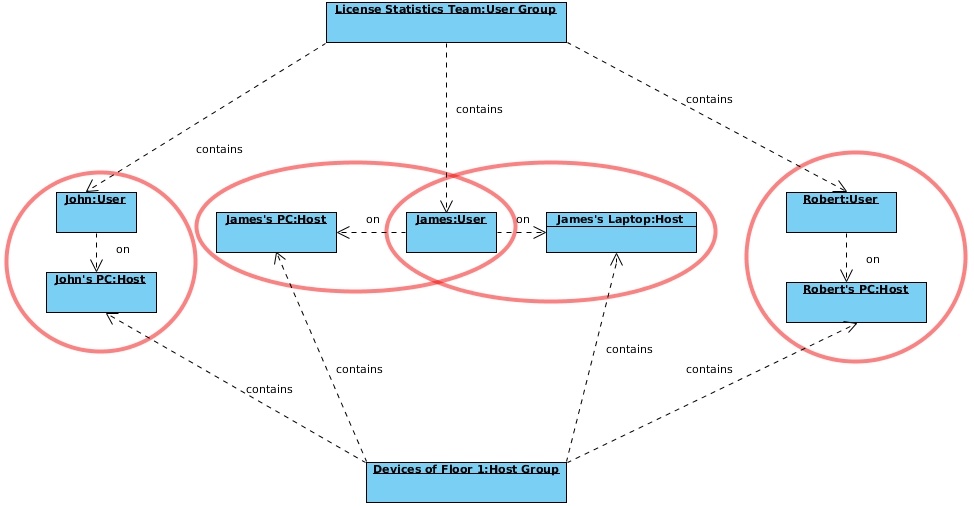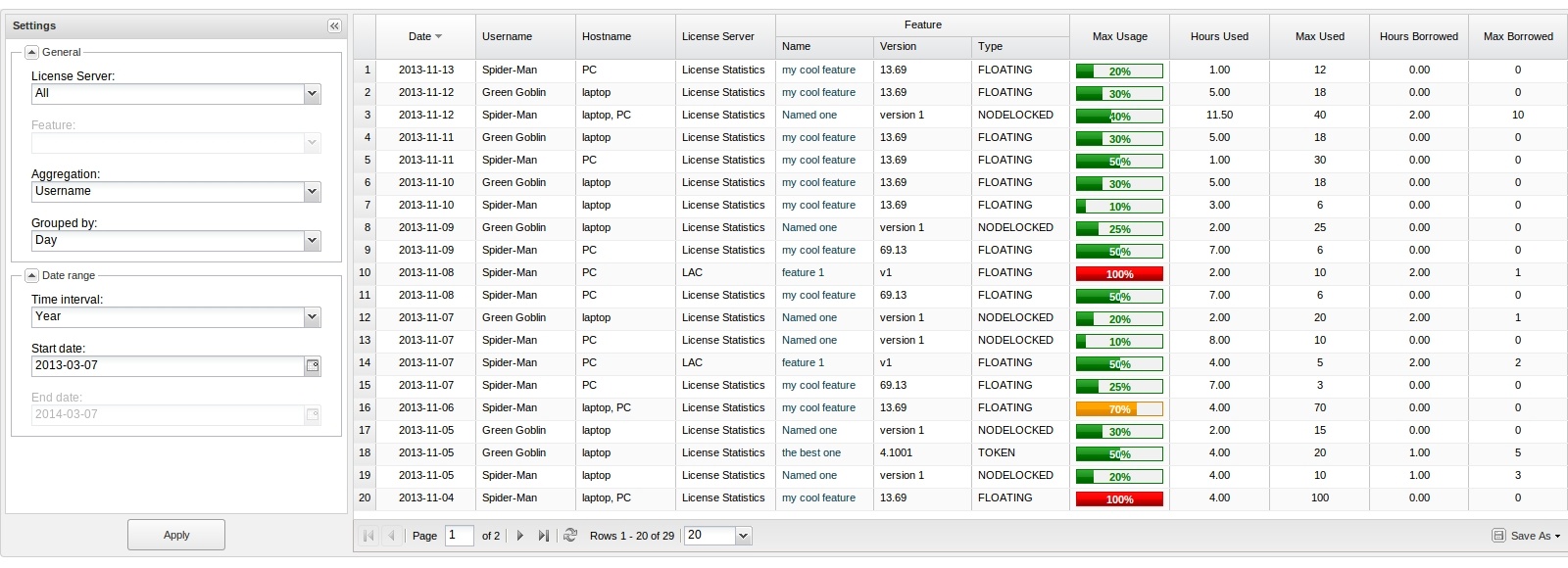The information on this page refers to License Statistics v4.6 or newer, which added license server groups. If you are using an earlier version, please refer to the documentation for releases prior to v4.6. |
To see a report on the usage of feature, select the Usage Per User tab from the Reports page.
General Information
The Usage Per User report shows license usage information for all features or a selected feature, for one or all monitored license servers.
Before you produce a Usage Per User report, you can specify the type of aggregation to use for the report. You can also group feature usage information, as described in subsequent sections, below.
Types of aggregation
You can specify the type of aggregation by which you can aggregate the results for the report. If the aggregation type is not specified, the report will be aggregated by Username and Hostname. Available options are:
How aggregation is applied in a report
The minimum aggregation value you can specify is User on Host, which means that this unit that cannot be split further. The values for other available aggregations such as Hours Used/Borrowed, Max Used/Borrowed and Max Usage, are calculated using different aggregation methods (for example sum), based on the calculations of the values set for User on Host for a particular moment of time.
Example
Let’s assume we have selected to show feature usage information by Usergroup. As shown in the diagram below, we can split this usage information into information for particular Users. This information can be split even further into usage for User on Host. This mechanism shows that the values of usage for User are aggregated values of User on Host.
Grouping feature usage information
Depending on your needs, you can group feature usage information by the following units of time:
- Day
- Week
- Month
- Quarter
How grouping by a unit of time works in a report
Grouping by a unit of time lets you group values from specified fields together, providing a single record of, thereby providing a single record of distinct values for each group.
Example
Let's assume the following values have been returned after grouping feature usage information by Month.
| Date | Hours Used |
|---|---|
| 2014.04.01 | 10 |
| 2014.04.02. | 20 |
| 2014.04.04 | 30 |
| 2014.04.06 | 40 |
When we choose to group the above feature usage information by Month and set the start date to April 4, 2014, we obtain the following values:
| Date | Hours Used |
|---|---|
| 2014.04. | 70 |
When we decide to set the start date to April 1, 2014, we get the following values:
| Date | Hours Used |
|---|---|
| 2014.04. | 100 |
Grouping works in the same way for all other available time units, for any set of selected values.
The minimum value you can group by is Day. As in the case with aggregation values, the values of columns grouped by other available options are calculated based on calculations of values set for Day for a particular aggregation.
Feature Usage Information
You can see a list of hostnames/usernames included in the existing Hostnames/Usernames columns when aggregating by a particular aggregation option, and to maintain the visibility of Username/Hostname columns when aggregating by a different aggregation option.
The feature usage information includes the following:
| Column Name | Description |
|---|---|
| Date | A particular day or period of time, whose format depends on the selected grouping option.
|
| Hours Used | The number of hours at least one license of a particular feature was used and/or borrowed. |
| Hours Borrowed | The number of hours at least one license of a particular feature was used and/or borrowed. |
| Max Used | The maximum number of licenses used in a particular time period. |
| Max Borrowed | The maximum number of licenses borrowed in a particular time period. |
| Max Usage | The maximum allowed level of feature usage, expressed in percentages. |
Example
To better understand how possible aggregation scenarios work, let’s look at the following example:
| Column | Aggregation Type | Scenario | Remarks |
|---|---|---|---|
| Hours Used/Borrowed | User | In our example, the results shown in the report are limited by Day. Scenario 1 The user uses 1 license for 8 hours. Calculation: 8 hours = 8 Hours Used Scenario 2 The user uses 2 licenses for 1 hour and then 10 licenses for 2 hours and 1 license for 2 hours. | When you choose to use a different aggregation type or when you decide to group by a different value, the sum of the values will be displayed for the following: a). Days in a time frame b). Entities (for example; user, host) in a particular aggregation. |
| Max Used/Borrowed | User | In our example, the results shown in the report are limited by Day. Scenario 1 The user uses 2 licenses in 1 day. Calculation: 2 licenses = 2 Max Used/Borrowed Scenario 2 The user uses 2 licenses in 1 day, but for 1 hour he uses only 1 license Calculation: 2 licenses = 2 Max Used/Borrowed | When you choose to use a different aggregation type or when you decide to group by a different value, the highest value will be displayed for the following: a). Days in a time frame b). Entities (for example user, host) in a particular aggregation. |
| Max Usage | User | In our example, the number of available licenses for a particular feature is 10. Scenario 1 The user uses 2 licenses in 1 day. Calculation: 2 licenses out of 10 licenses = 20% Scenario 2 The user uses 5 licenses for 1 day, but for 1 hour he needs and uses only 2 licenses. Calculation: 5 licenses out of 10 licenses = 50% Scenario 3 The user uses 3 licenses in 1 day, but for 1 hour he needs and uses 8 licenses. Calculation: 8 licenses out of 10 licenses = 80% | When you choose to use a different aggregation type or when you decide to group by a different value, the same method of calculation will be applied. It should be noted that the Max Usage value may serve as a warning signal, giving you information about the highest values of feature usage. It is worth considering if the values represent a one-time event or a tendency. |

